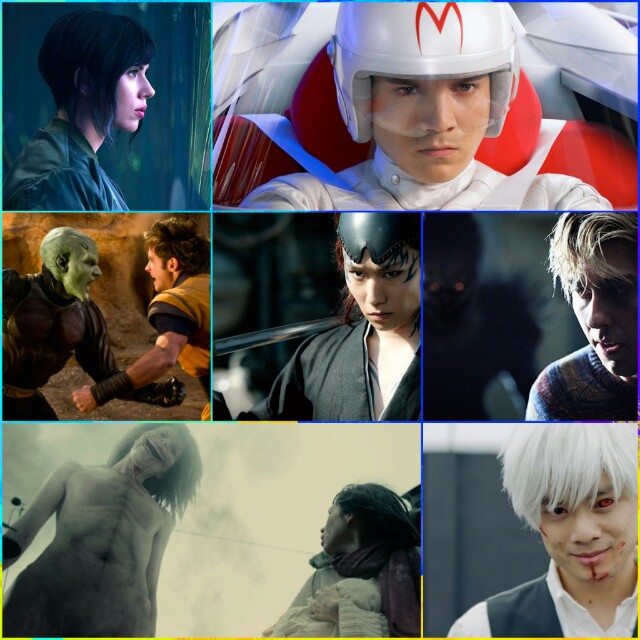The rising (picture) show: the advent of anime adaptations
May 10, 2019
When the stages of production for 2019’s Alita: Battle Angel commenced in 2017, viewers lacked any real reason to feel excited: for one, the film found itself stuck in development hell since 2003, when noted director James Cameron signed on to direct the film. However, his work on projects including Dark Angel, Aliens of the Deep, and Avatar resulted in script delays.; the film then bounced from Cameron to Spy Kids director Robert Rodriguez, as the former instead chose to serve as producer.
However, a far more potent reason for skepticism towards the film deals less with the film itself, and more with the egregious mold, it fits into—the anime adaptation. As the name implies, such movies take series done in the Japanese animation style and adapt them into live action. Though a rather simple task on paper, live-action anime films possess a notorious reputation among the anime community and film critics alike for their poor quality: films most notably mentioned when discussing this topic include 2009’s Dragonball Evolution, 2015’s Attack on Titan, and 2017’s Death Note.
Common complaints include compressing hours worth of story into one film, whitewashing the cast, and a general misunderstanding of the source material. As such, fans and filmgoers make their discontent with these films heard, as anime adaptations tend to flop at the box-office. In spite of these failings, it seems that these films will continue to find a home in theaters and streaming services. When discussing these anime adaptations, their failings most often dominate the discussion; however, the most comprehensive analysis of these films requires an examination of not just their failing or even the history of these films, but the entire art form of anime as well.
Considering the exhaustive history anime possesses, it stands to reason that a fair share of misconceptions regarding its origins would exist. General consensus agrees that the genre never truly found its footing until the late 1940s with the birth of Toei and animated films and shows like 1959’s Shōnen Sarutobi Sasuke and 1966’s Sally the Witch, respectively.
In all fairness, both anime brought with them major landmarks in the history of anime: Sasuke became America’s first theatrically released anime in America, and Sally holds the distinction of founding the magical girl subgenre. However, anime’s birth took place in 1907 with a short filmstrip titled Katsudo Shashin; depicting a young boy writing on a boat, the short predates the creation of anime’s greatest icons by over a half century, as well as preceding Walt Disney and American icon Mickey Mouse by over 20 years.
That does not mean that the 1960s did much for anime, as this decade marked the birth of several series which would later influence entire generations of creators and pioneer new tropes: these anime include Tetsuwan Atom, Tetsujin #28-Go, and Mach GoGoGo, better known to the American audience as Astro Boy, Gigantor, and Speed Racer respectively. No live action anime films came out during this decade; however, two animated films appeared based on Cyborg 009 (one of the same name and Monster Wars) and another animated film titled Alakazam the Great, which combined Osuma Tezuka’s Boku no Son Goku and Wu-Cheng’en’s 16th century novel Journey to the West.
While one would (quite reasonably) assume that the 70s saw considerable expansion in anime’s scope, this statement contains a partial truth: anime did evolve in this time but in a more subtle manner. The only notable anime to come out during this time include Lupin III (Green and Red Jacket), Doraemon (which restarted in 1979), and Mobile Suit Gundam; the latter’s notoriety comes from the fact that it spawned an entire sub-genre of anime. All in all, though, the nascent anime industry saw minimal growth in the ’70s. Despite this phenomenon, this decade saw an immense amount of live-action anime films: the martial arts manga Lone Wolf and Cub spawned six films alone, beginning in 1972 and ending in 1974. In addition, a film based on Lupin II, titled Strange Psychokinetic Strategy, came out around this time.
Making up for the comparatively minimal expansion of anime in the 70s, the 80s and 90s resulted in the largest growth within the context of anime’s popularity. The “first generation” of anime, released during this time, such as Sailor Moon, Neon Genesis Evangelion, Voltron, Fist of the North Star, and Dragon Ball (and sister series Dragon Ball Z), eventually became among the most popular of all time; their impact exists in the form of influencing blockbuster films, feminist theories, and even contemporary anime (which later went on to influence video games). Therefore, to ride the wave of anime’s current success, a veritable mishmash of anime-based films came out during the ’80s and ’90s.
For the former decade, the vast, vast majority of these films featured no real actors, but instead animation. Of the films released during this time, the only live-action films of note included Shogun Assassin (based on and compiling footage from the Lone Wolf and Cub films) and A-Homansu, based on a manga by Carib Marley. For the latter decade, viewers found themselves exposed to far more anime films, but most featured animation, namely Dragon Ball movies 3-13, Yu-Gi-Oh!: The Movie, and Ghost in the Shell.
One notable live-action film hit theaters during this time, with its release marking a notable shift in how critics review these anime adaptations. This film, Fist of the North Star, adapted the anime of the same name into live action. The film, while largely forgotten today, earned scorn for, in the words of an eFilmCritic review, lacking “the kinetic powers of Japanese animators”; the significance of this arises due to its status as one of the first times an anime adaptation faced critique (from fans or critics) for not meeting the standards of its anime counterpart.
One possible rationale for this watershed ties into the state of anime during the 2000s. The impact of shows released during this time was comparable to those released during the ’80s and ’90s: InuYasha, Yu-Gi-Oh! Bleach, Naruto, Fairy Tail, One Piece and more debuted during this time, with the latter three forming the Holy Shonen Trinity (HST).
More importantly, this time period marked the peak of anime’s popularity in the Western world with the Toonami television block on Cartoon Network. Originating in 1997 as a daytime block, Toonami served as the gateway for an entire generation of future anime viewers; this event not only influenced American cartoons but created a community of fans more critical of their beloved properties. This phenomenon originally consisted of critiquing certain anime dubs or a production company’s policies; as anime grew in popularity, so too did live action anime films propagate within movie theaters during the 2000s.
Most of these films came from Japan: Tetsujin 28: The Movie, the first Death Note film (as well as sequel The Last Name and spin-off L: Change the World), and The Prince of Tennis, named after the eponymous Japanese manga. All these films earned somewhat positive reviews from fans and critics alike for properly adapting the source material while remaining competent films in their own right.
As for the American films released during this time, their release unintentionally sparked the precedent of negatively received live-action anime films. This started with 2008’s Speed Racer, based on the Japanese anime MachGoGoGo: though the film now exists as something of a cult-classic, critics called the film out upon its release for its incoherent visual style and “pandering to…low-brow, nostalgic crowds”. However, 2009’s Dragonball Evolution truly set up fan hatred for these kinds of films. Since and after the release of the film, anime fans critiqued this film for various issues: a poor script, bad acting, an inability to translate even the most basic elements of the series to live-action, and far more. With its consistent placing as the worst anime adaptation ever made, even series creator Akira Toriyama condemned the film.

All this brings us into the modern age: with the stench of Dragonball Evolution still fresh in fans’ mind, it would stand to reason that film executives would elect to avoid producing these kinds of films, as they fail to draw in fans of the source material or even general moviegoers. For whatever reason, the 2010s produced a larger resurgence of films based on fairly high-profile anime, to the same results: 2015’s two-part Attack on Titan film earned scorn for hamfisted exposition, “fetishization” of WWII German uniforms, and bad acting; Spike Lee’s 2013 remake of 2003’s Oldboy (itself an adaptation of the manga series of the same name) bombed at the box-office and earned mostly unfavorable reviews from critics. Moreover, 2017’s American Death Note film, released by Netflix, received middling reviews due to source material deviation and poor characterization. All in all, the world of contemporary anime-based feature films presents a disappointing but unsurprising landscape.
This feeling of disappointment regarding anime adaptations among the mainstream audience and anime fans online: certain fans of the art form within the Acworth-Kennesaw community hold their own positions on the matter. Unlike other adaptation detractors and anime fans, whose main gripes lie with the storytelling of these films, one NC student sees these films as guilty of a more severe offense.

“I think they’re usually culturally insensitive, just because a lot of American producers don’t understand all the nuances of Japanese culture; so unless it’s a Japanese-American (producing the adaptation) who might understand it (Japanese culture) more, I think they’re…not very good adaptations. If anything, it should be left to the Japanese people to make adaptations of their own media, instead of us, because it’s usually not faithful to the source material”, junior Catalina Andrae affirmed.
Accuracy to the source material tends to dominate discussions when it comes to media adaptations, anime or otherwise. While the discussion encompasses a wide array of differing perspectives, the general consensus seems to argue that filmmakers should prioritize the making of a solid film over a faithful adaptation of the source material, or in the words of AV Club’s Scott Tobias: “the impetus to be faithful…should not be part of the equation”. This sentiment makes some sense: an overly faithful adaptation will struggle to present its own merits and fail to distinguish itself as anything besides a live-action version of its source material. Still, it seems there exist other reasons as to why anime adaptations, regardless of accuracy to material, fail that tie into accuracy.
“I think that the biggest reason live action anime movies aren’t as successful in America is that they don’t normally go off of the source materials. For example…, the new Death Note on Netflix: a lot of what they did in the movie was more catered to their audience in America rather than going off of what the original (anime) was. A lot of people didn’t like it…because they went into it expecting…a carbon copy of what the cartoon was, and got something completely”, junior Donovan Hall asserted.
The contrast between the styles of anime and Western film often comes up. As any viewer of anime (casual or otherwise) can attest, anime possesses an extremely distinct visual style: tropes like nosebleeds, sweat beads, and exaggerated veins popping take full advantage of boundaries provided by both Japanese visual culture and animation in general; this distinctive style also applies to action. Hollywood, however, works differently: though CGI continues to advance greatly, it and every visual aspect of Hollywood (makeup, costume/set design, etc.) must ultimately accommodate the limits of the real world. This dissonance between the limits of live-action and the visual necessities anime demands remains arguably the greatest point of contention regarding the manner of anime adaptations, and a deal-breaker for some fans.
“I feel like any anime…can’t be made into a live-action movie, because of the amount of detail that should be put into the live action movie. For instance, there are [large] facial expressions in the anime; you can’t…put that on a…person. Yes, you can try to do as much expression as possible, but…anime characters express their emotions quite big. It could be possible, but I think if anything, the…movie would be better [if it were not] live action,” senior Gina Trotta asserted.
In spite of the negativity commonly associated with these adaptations, the future of anime adaptations looks bright. This year’s Alita: Battle Angel (despite mediocre critical reviews and somewhat disappointing box-office numbers) became a surprise hit among anime fans and casual moviegoers alike. Not to mention, not all adaptations received the same levels of scorn or even any scorn: 2018’s BLEACH earned praise for properly adapting the anime’s mythology while keeping simple enough for new viewers to understand, and the Japanese adaptation of Tokyo Ghoul earned a positive reception from both critics and audiences. With adaptations of popular anime like Naruto and Akira planned for the 2020s, it seems that Hollywood finally managed to walk the path to translate these beloved works of fiction to the silver screen, and according to one NC student, the best way to stay on the path requires the most basic component of any story-good writing.
“I don’t think live-action anime films are doomed (to failure), I feel like there’s potential in everything. But…it’s up to directors and the production team to really make the story do well on the big screen. It has to have good writing-you can take a good art style, (but) if you plop that on a bad story, you’re going to have a bad film. I think anime, in general, is an underrated art form, but I think it definitely has potential in the U.S. I think it can flourish under the right team”, sophomore John Merkin suggested.

Rose Martine • Oct 24, 2019 at 4:54 AM
“What’s up friends, pleasant piece of writing and good arguments commented
at this place, I am really enjoying by these.”
Regards
rose martine